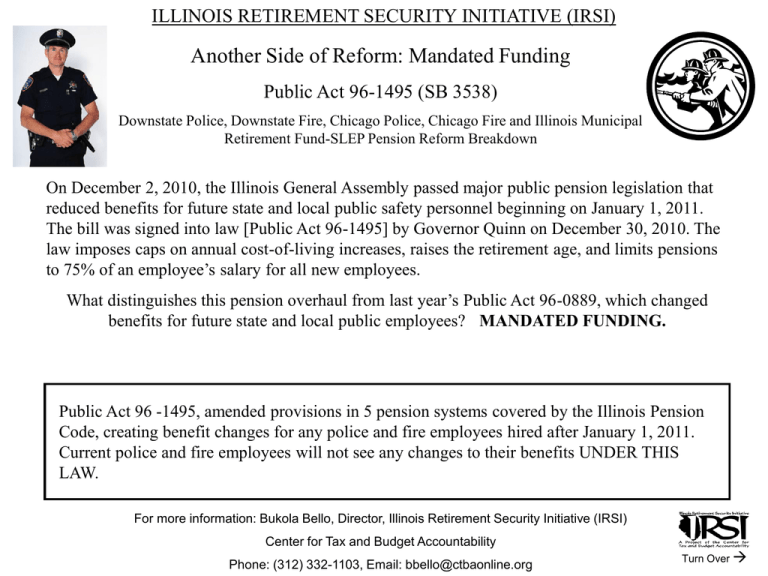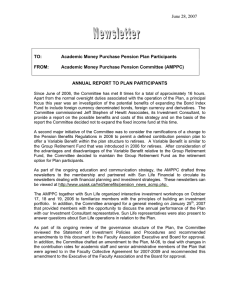Another Side of Reform: Mandated Funding ILLINOIS RETIREMENT SECURITY INITIATIVE (IRSI)
advertisement

ILLINOIS RETIREMENT SECURITY INITIATIVE (IRSI) Another Side of Reform: Mandated Funding Public Act 96-1495 (SB 3538) Downstate Police, Downstate Fire, Chicago Police, Chicago Fire and Illinois Municipal Retirement Fund-SLEP Pension Reform Breakdown On December 2, 2010, the Illinois General Assembly passed major public pension legislation that reduced benefits for future state and local public safety personnel beginning on January 1, 2011. The bill was signed into law [Public Act 96-1495] by Governor Quinn on December 30, 2010. The law imposes caps on annual cost-of-living increases, raises the retirement age, and limits pensions to 75% of an employee’s salary for all new employees. What distinguishes this pension overhaul from last year’s Public Act 96-0889, which changed benefits for future state and local public employees? MANDATED FUNDING. Public Act 96 -1495, amended provisions in 5 pension systems covered by the Illinois Pension Code, creating benefit changes for any police and fire employees hired after January 1, 2011. Current police and fire employees will not see any changes to their benefits UNDER THIS LAW. For more information: Bukola Bello, Director, Illinois Retirement Security Initiative (IRSI) Center for Tax and Budget Accountability Phone: (312) 332-1103, Email: bbello@ctbaonline.org Turn Over HISTORIC FUNDING MANDATE: Effective 1/1/2011 the actuarial methodology was changed to require the calculations of the actuarial requirement to be made using the "projected unit credit method, " which produces a much lower contribution than the prior method, which was entitled “entry age normal cost”. The section of the new law which mandates that municipalities meet their pension obligations demands that the funding formula shift (in 2015) to an actuarially based formula. Municipalities who continue to fail to meet their pension obligations after 2015 can have a portion of their income or sales tax diverted to cover the costs of their obligations. Additionally, the funding target was lowered to 90% by 2040 instead of 100% by 2033. These changes ensure that municipalities can no longer shortchange the pensions of hard working public safety personnel. P.A. 96-0889 (SB 1946) Employees Normal Retirement Age (full pension) Vesting Earliest Retirement Age (reduced pension) State and Local Public Employees 67 years of age P.A. 96-1495 (SB 3538) Police and Fire, IMRF-Sheriff’s Law Enforcement Program (SLEP) 55 years of age 10 years 8 years 62 years of age with 6% reduction in pension for each year prior to 67 50 years of age with a 6% reduction in pension for each year prior to age 55 Final Rate of Earnings Average of highest 96 months (8 yrs) in last 120 months (10 yrs) of service Final Rate of Earnings Cap Caps pensionable salary at $106,800; amount automatically increases annually by the lesser of 3% or by one-half of the increase in the Consumer Price Index (urban) for the preceding year. Caps pensionable salary at $106,800; amount automatically increases annually by the lesser of 3% or by one-half of the increase in the Consumer Price Index (urban) for the preceding year. Surviving Spouse Pension 66-2/3% of the pension the member had earned at the date of death. 66-2/3% of the pension the member had earned at the date of death. Lower of 3% or one-half of the increase in the Consumer Price Index (urban) for the preceding year of the original amount. Retirees and survivors will receive COLAs equal to 3% or one-half of the Consumer Price Index (urban) the year after their 60th birthday. Cost of living Allowance (COLA) Average of highest 96 months (8yrs) in last 120 months (10 yrs) of service




